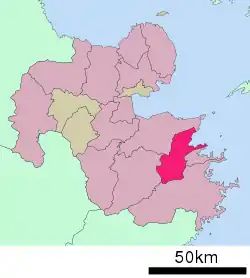Usuki
臼杵市 | |
|---|---|
.JPG.webp) Usuki City Hall | |
 Flag  Seal | |
Location of Usuki in Ōita Prefecture | |
 | |
 Usuki Location in Japan | |
| Coordinates: 33°07′34″N 131°48′19″E / 33.12611°N 131.80528°E | |
| Country | Japan |
| Region | Kyushu |
| Prefecture | Ōita |
| Government | |
| • Mayor | Goro Nakano (since January 2009) |
| Area | |
| • Total | 291.20 km2 (112.43 sq mi) |
| Population (October 1, 2023) | |
| • Total | 34,155 |
| • Density | 120/km2 (300/sq mi) |
| Time zone | UTC+09:00 (JST) |
| City hall address | 72-1 Usuki, Usuki-shi, Ōita-ken 875-8501 |
| Website | Official website |
| Symbols | |
| Flower | Salvia splendens |
| Tree | Kabosu |
_Oita%252CJAPAN.jpg.webp)

Usuki (臼杵市, Usuki-shi) is a city located on the east coast of Ōita Prefecture, Japan. As of 1 October 2023, the city had an estimated population of 34,155 in 14538 households, and a population density of 120 persons per km². [1] The total area of the city is 868.02 km2 (335.14 sq mi). It is famous for its Usuki Stone Buddhas, a National Treasure, and its soy sauce production.
Geography
Usuki is located in east-central Ōita Prefecture, bordered by the prefectural capital at Ōita City to the north. The eastern part faces the Bungo Channel and stretches along Usuki Bay, surrounded by the Saganoseki Peninsula to the north and the Nagame Peninsula to the south. Within the bay are Kuroshima Island and Tsukumi Island. The main urban area is on the plains around the mouth of the Usuki River, which flows into Usuki Bay. The inland area consists of gentle hills in the north and rising to an elevation of 500 to 600 meters in the south.
Neighboring municipalities
Climate
Usuki has a humid subtropical climate (Köppen Cfa) characterized by warm summers and cool winters with light to no snowfall. The average annual temperature in Usuki is 15.6 °C. The average annual rainfall is 1759 mm with September as the wettest month. The temperatures are highest on average in August, at around 26.1 °C, and lowest in January, at around 6.5 °C.[2]
Demographics
Per Japanese census data, the population of Usuki is as shown below
| Year | Pop. | ±% |
|---|---|---|
| 1960 | 61,337 | — |
| 1970 | 52,434 | −14.5% |
| 1980 | 51,302 | −2.2% |
| 1990 | 48,754 | −5.0% |
| 2000 | 45,486 | −6.7% |
| 2010 | 41,469 | −8.8% |
| 2020 | 36,158 | −12.8% |
History
The area of Usuki was part of ancient Bungo Province. During the Edo period it was mostly under control of Usuki Domain and was ruled by the Inaba clan, with smaller areas under control of Saiki Domain and Kumamoto Domain until the Meiji restoration. William Adams, Jan Joosten, Jacob Quaeckernaeck and Melchior van Santvoort got stranded on the coast of Bungo, now Usuki City, in April 1600, on the ship "De Liefde", marking the first contact that led to many years of Dutch-Japanese trading partnership.[3] The town of Usuki within Kitaamabe District, Ōita was established on May 1, 1889 with the creation of the modern municipalities system. On July 1, 1907 Usuki annexed the neighboring villages of Hamamura, Shimonantsuru, and Kamiura. On Usuki merged with neighboring Umibe village and was raised to city status. April 1, 1950. On March 31, 1954, Usuki expanded by annexing the villages of Sashibu, Shimonoe, Kamikita Tsuru, Shimokita Tsuru, and Minami Tsuru.
On January 1, 2005, the town of Notsu (from Ōno District) was merged into Usuki.
Government
Usuki has a mayor-council form of government with a directly elected mayor and a unicameral city council of 18 members. Usuki contributes two members to the Ōita Prefectural Assembly. In terms of national politics, the city is part of the Ōita 2nd district of the lower house of the Diet of Japan.
Economy
Primary industries such as agriculture and fishing, shipbuilding, and brewing industries such as soy sauce and miso. The city is well known for its kabosu fruits. Economically, it belongs to the Ōita metropolitan area and has close ties with Ōita City. In particular, the shipbuilding industry accounts for 73% of the total output of the city's manufacturing industry. Tourism is also an important contributor to the local economy and Usuki is actively promoting its look and feel of a Japanese jōkamachi.
Education
Usuki has 13 public elementary schools and five public junior high schools operated by the city government. The city has two public high schools operated by the Ōita Prefectural Board of Education. The prefecture operates one special education school for the handicapped.
Transportation
Railways
- Sashiu - Shitanoe - Kumasaki - Kami-Usuki - Usuki
Highways
Ferries
Ferries travel between Usuki and Yawatahama City in Ehime Prefecture, Shikoku through the two ferry companies Kyūshi Orange Ferry and Uwajima Unyu Ferry.
Sister city relations
Local attractions
- Usuki Stone Buddhas, a national treasure and special historical landmark
- Usuki Castle
- Nioza Historical Road
- Inaba-Family Villa, a former samurai residence
- Hakubakei
- Furen Limestone Caves, a national monument
- Meiji Bridge
- Nogami Yaeko Memorial Museum
- Fugen Temple, burial site of Kicchomu
- Usuki City Historical Museum
- Naora Nobuo Memorial Museum
 Ruin of Usuki castle Furuhashi gate
Ruin of Usuki castle Furuhashi gate Nioza_Historical_Road, facing Zenshōji
Nioza_Historical_Road, facing Zenshōji Kuge_no_Okura sake brewery
Kuge_no_Okura sake brewery Zentoku-ji
Zentoku-ji
Festivals
Major festivals in Usuki include the Usuki Gion Matsuri (mid July), Usuki Stone Buddhas Fire Festival (late August), and Usuki Bamboo Lantern Festival (early November). There are also festivities and celebrations during the cherry blossom blooming period in April, for example at Usuki Castle.
Noted people from Usuki
- Tatsuo Yamamoto, politician
- Tadatomo Yoshida, politician
- Yaeko Nogami, novelist
- Jun Hirose, baseball player
- Hiromi Wada, baseball player and commentator
- Masako Miura, voice actress
- Maiko Itai, model and Miss Universe 2010
- Keiko Komuro, singer
In popular culture
Movies set in Usuki
- なごり雪 (The Last Snow) (2002)
- 22才の別れ Lycoris 葉見ず花見ず物語 (Exchange Students - Goodbye to You) (2007)
References
- ↑ "Usuki City official statistics" (in Japanese). Japan.
- ↑ Usuki climate: Average Temperature, weather by month
- ↑ "Japan-Netherlands Exchange in the Edo Period". ndl.go.jp. Retrieved 2022-10-14.
External links
 Media related to Usuki, Ōita at Wikimedia Commons
Media related to Usuki, Ōita at Wikimedia Commons- Usuki City official website (in Japanese)
- Usuki City Tourism Promotion Film 2014